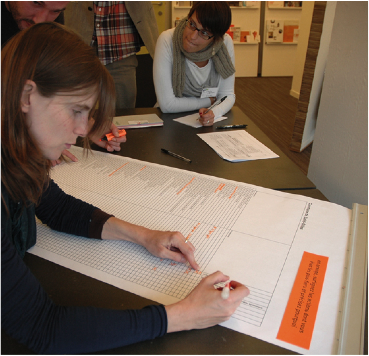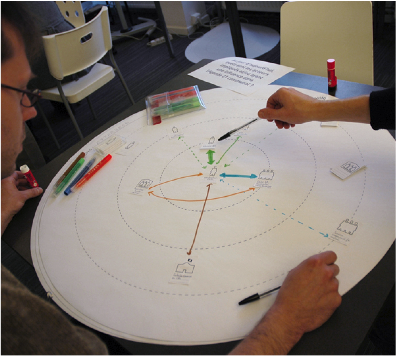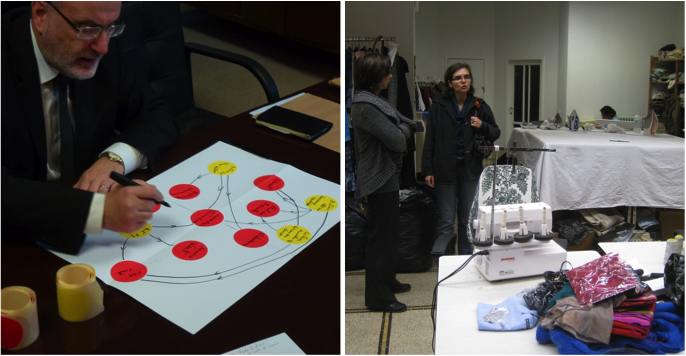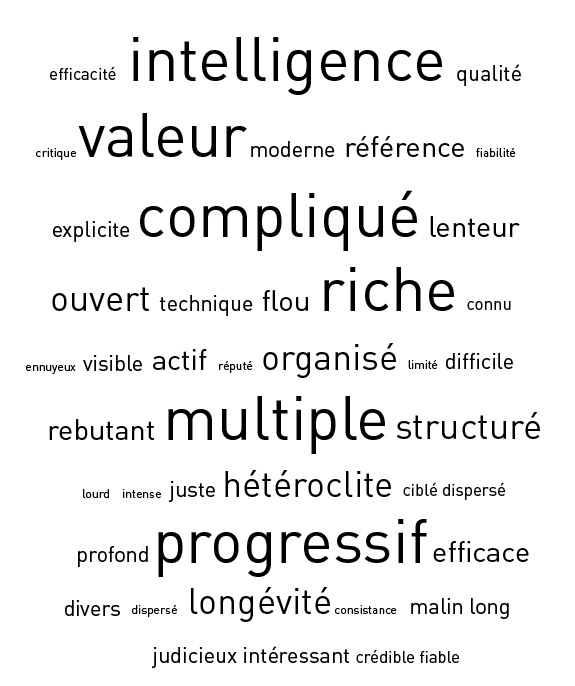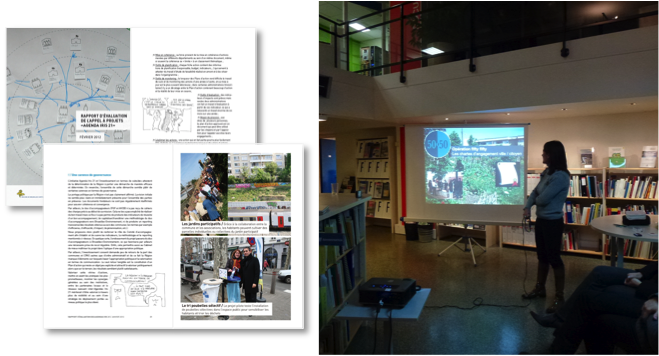Methodology
Both scenarios building processes took place over at the same period between Autumn 2011 and Spring 2012. Beyond the similarities in goals leveraging on Rio+20 event to question achievements of Agenda 21 local processes and involve stakeholders to co-develop scenarios exploring their possible futures, the respective national context in France covering between 700 and 800 Agenda 21 processes and the regional context in Brussels-Capital covering between 20 and 40 Agenda 21 processes is obviously very different. Therefore, more than a comparison of both parallel participative scenario building methodology that would hardly make sense, this section will review the different tools and methods adapted to both different contexts and study specific settings to outline the characteristic of the general co-design approach promoted by Strategic Design Scenarios.
Collaborative workshops with Agenda 21 stakeholders
In both cases different collective workshops have been organized with the different stakeholders involved in respective Agenda 21 processes. Beyond the difference of scale between national and regional level underlined before, the number of participants involved ranged from 15 to 25 for main stakeholders (local responsible of Agenda 21, external supports, network and cluster organizations and national/regional coordination). In Brussels as second range of 40-60 secondary stakeholders (elected people, civil servants, local NGOs, citizens…) were also involved for the purpose of the assessment process.
If we focus our description on the interaction with core stakeholders, the design of the workshops is aiming at kicking the participants out of the classical administrative reporting modes to stimulate creative interaction both within and between each of the Agenda 21 processes.
The workshop with civil servants responsible of the Agenda Iris 21 in Brussels for instance was organized as a one day open atelier (Figure 1) where each local Agenda Iris 21 responsible was asked to gather and invite the necessary representative team s/he consider could better represent the Agenda Iris 21 process s/he is responsible of. Different sub-ateliers were available for participants to visit in a random process. For each of them specific activities were designed:
> Stakeholder mapping on a circular map organized in concentric circles and under a webcam to videotape the construction process of the map and replaying the recording in accelerate, better understand the mental representation of social proximities;
> Set of questions-cards where participants have to decide which cards they choose to answer to make most sense of their local Agenda Iris 21 process;
> Long prints of the Action plans where to highlight actions so that it makes sense from different points of view: progress in terms of transversality, systemic change of gouvernance, visibility for citizens, etc…
The purpose of the whole setting is to promote self-creative assessment where participants are enabled to change and try different postures to observe their own process, build what will make most sense of it and prove it themselves; detect gaps, barriers and enablers to enrich progressively future visions The collective dimension of the open atelier allows mutual comparisons and cross-fertilizations between the different self-assessment processes to generate a collective vision. One of the interesting findings that emerged for instance is the collective acknowledgment of a gap between the environment competences involved on the field and the fact that most of the barriers detected regards governance issues. The collective vision for future of Agenda Iris 21 is therefore requiring a better design of the policy dimension of the Agenda 21 process based on more transversality to break the administrative silos; a more structural and central position in the political process; more synergic governance across administrative levels and between institutions.
Immersion sessions in the local institutions involved
In the Brussels-Capital region, in-depth investigations to further investigate findings from desk researches and workshops with Agenda 21 coordinators were conducted in three different Communes and CPAS involved. The purpose was first to literally ‘visit the Agenda 21 Action plan’ in order to assess at real size and in action where was the real values of what was achieved and second to grasp through what people had to say – or not – about the local Agenda 21 process what was the on-going local dynamic. More than a series of appointments with the key stakeholders, the intention was to settle for 2 days in the focus public institution and improvise with formal and informal meeting when there, betting more on informal moments and spontaneous interactions rather than planned and organized meetings. 2 days are short for such a strategy requiring a minimum of time to build trust with the different populations working in the institution and for unpredicted interactions to happen, especially that the aim was also to investigate outside the institution civil society organizations and other players that may have stakes in the Agenda 21 process.
Opposite to classical methods, immersions – event short ones – brought a great value leveraging on a seriesw of effects that operates even after the first morning on the place:
> The guest effect: in a public institution people are rather working or passing for a short time and in both case they have specific tasks to do. Being a guest for 2 days is rather unusual especially if being a guest with no specific tasks to do. It triggers the curiosity and a certain sympathy of the civil servants;
> The informal posture is particularly interesting for taking opportunities of seeing people between 2 appointments, exchanging some words in the corridor or even bringing you sandwich and sharing their lunch table. Long appointments are not always necessary to pick-up the mood of a situation and informal encounters are often richer than formal meetings;
> The bouncing ball effect is the phenomenon when the interaction with one person pulls another: people introduce you to colleagues in the corridor, pick-up their phone to try a last minutes encounter and bouncing from one person to another you see many more people than with the tightest planning;
> The residence posture derives from settling in the place, behaving like employees and therefore meeting people more than one time during the immersion as a sort of new temporary colleague.
We insist here on the in-depth field involvement that is necessary to ground understanding of a process like Agenda 21 into the experience on the spot – even a short experience – to complete a conceptual study by a sensitive human approach. Such a quick immersion is not always as smooth as it may appear – some institution were first a bit scared of this informal, commando-like intrusion – but they generate insights from the real users or stakeholders. For instance in this case, the coordinators of Agenda Iris 21 visited appeared clearly in a very paradoxical posture: the more they are integrated in the institution and therefore metabolized by the traditional administrative structure, the less they seems to be able to leverage on their position to reform the governance of the institution. On the contrary, the apparently more instable and uncomfortable postures, floating between departments, both inside and outside – in a way a similar posture to the one we experience during the immersion session – seems to be more appropriated to assume the transversal activities of an Agenda 21.
Collaborative scenario building workshops
The scenario building process conducted with the French foresight group Rio+20 and after: the future of the Agenda 21 is articulated in two steps: a visioning activity outlining the desirable situation that future Agenda 21 should help to achieve and a backcasting activity establishing the necessary steps and their articulation to pass from the current situation to the desired vision expressed in the first step. The complete scenarios building process is grounded also on an Assessment of the current situation and achievements based on an overview of the more than 700 Agenda 21 in France and on the exploration of the strategic environment to deliver a short list of Hypothesis of evolution of French Agenda 21.
The foresight group is constituted of between 20 and 30 coordinators the most active Agenda 21 at various urban, departmental, regional levels with representatives of coordination bodies and research NGOs at the national level. It meets for five one and half-day intensive workshops around a series of creative and interactive exercises to invent new visions of evolved Agenda 21 processes and build collaboratively qualitative scenarios. We present here four of the key exercises proposed:
> 8 local challenges for 2032 aligned with Grand Challenges at European level have been proposed to tease current Agenda 21 and prompt participants to imagine how settings of Agenda 21 should have changed at the horizon of 2032 in order to play a significant role in solving these local challenges;
> The visions of evolved Agenda 21 emerging from the confrontation with the local challenges was pictured through a large and varied pallet of media (i.e. an article in a national newspaper; an assessment of effective role played by the local Agenda 21; the programme of a conference organised by the Ministry of Environment, etc) in order to grasp the multiple facets of the vision;
> Subgroups of participants develop stakeholders roles in implementing or supporting the implementation of evolved Agenda 21. They act as local citizens, Mayors or representative of the State government to visualise the new stakeholder panorama in short video sketches;
> 2 meters long timelines where proposed to define for each of the selected visions appropriated policy measures, local projects, resulting actions and consequences along the timeline articulated with transition arrows in order to establish the necessary evolution process from the present Agenda 21 and assess the credibility and robustness of each step to occur and produce the desired vision for Agenda 21 in 2032 to happen.
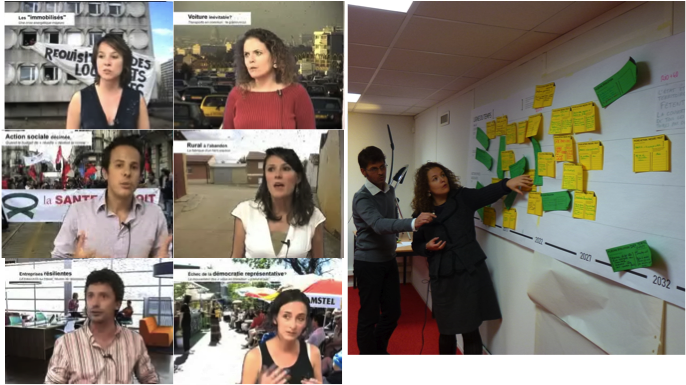
Investigation of Agenda 21 identity
Agenda 21 are nearly 20 year old: how are they perceived by the stakeholders of the sustainable development? What are theirs attributes as sustainable development tools? What is their reputation? Do they inspire trust? Which identity did they develop? The original concept issued from the World Summit in 1992 was widely open in order to include the multiple different initiatives of local sustainability worldwide. Therefore the identity formed is probably as heterogeneous as the different typologies of Agenda 21 but locally, within a relatively coherent national framework, it possible to outline it, to better grasp the identity capital that may be activated in the future and also the bias induced by the perception heritage.
If Agenda 21 was an object? An animal? A famous person? Would it be a friend? An enemy? Which tags would best qualify it? And unqualify it? Etc: a light questionnaire has been build using free association and projection techniques commonly used in the analysis of private brand perception fully conscious of the limits that this approach presents both in conceptual term (for the heterogeneity of levels and sizes of involved institutions) and symbolic terms (for the obvious antagonism with the consumerist culture that develop these very techniques).
A bit more than 30 civil servants, responsibles of NGOs and decision makers at various local, regional or national levels but all close to Agenda 21 processes took part to the experimentation and their answers brought to a series of tentative learning that could be summarized as such: Agenda 21 emerge as a very coherent brand: there is a convergence of its attributes whatever the question asked. It’s a brand based on humanistic values, respect, resilience and strong local roots whatever tomorrow will be, it will be there and accountable.
Beyond this robust background, Agenda 21 is perceived more as an environmental issue showing a certain misbalanced reported to the 3 pillars of sustainability. It lacks of visibility: entirely focussed on its mission it doesn’t take time to communicate its achievements and suffers from a lacks of recognition for that. The connotations associated are mainly positive but some are ambivalent: Agenda 21 assumes a difficult and noble task supporting local sustainable development and tends to develop an intransigent and dogmatic attitude and generate some rancour and resentment in its direct surroundings.
Beyond its limits, the exercise indicate that there is a capital of identity to investigate and that this capital show clear limits that cannot be stretched in any direction and should be handled appropriately in the possible evolution of Agenda 21 to be considered in the scenarios building process.
2.5 / Emblematic participative processes
Aside to these main blocs of activities both of the projection processes conduct in France and Brussels-Capital region intend to be coherent with the very principles of participation, transversality, creative involvement and traceability promoted in the Agenda 21. In particular three key aspects of implementation of the work all along the process should be mentioned.
Active partnership with ordering institutions
Both projection processes are based on a classical public contracting respectively and France and Belgium including a call for tender and subcontracting of consulting companies. In both cases the commitment of the institutions giving the order has been very high with active participation of the ordering institution staff to the projection processes, shared management and involvement in the co-production of the deliverables.
The Bureau des Territoires of the French MEDDTL organised together with two national research NGOs ETD and 4D form an informal steering committee contributing to organisation and synthesis, sharing with Strategic Design Scenarios the orientation and decision making about the research steps.
The initial settings of the collaborative and projective assessment ordered by the Brussels-Capital region includes from the beginning the region role in the assessment. The regular support committee was organised as real research workshop with active participation in analysis and shared steering of the process with representative from both Brussels Environment administration and cabinet of the regional MEEUR Ministry.
Although neither the French State nor the Brussels-Capital region have their own Agenda 21 they offered a shared and open partnership with their subcontractors aligning the research context with its object.
Active field experiences
Major risks with involving consulting third parties in assessment or projection activities is that whatever their involvement and the quality of their approach is, it remains ‘above-ground’ lacking of real scale experience and finally advising on something the intrinsically don’t know. The Agenda 21 process being by essence in both French and Brussels cases an internal process within public institution, it is unlikely to have experienced third parties.
Thanks to the setting of the Agenda Iris 21 in Brussels, both Strategic Design Scenarios and EcoRes had the chance to be involved in previous support and assistance to local Agenda 21: Strategic Design Scenarios supported the Agenda 21 of the commune of Molenbeek to organize citizens walks to foster the contribution of the population to the Action plan. It collaborate also with the Agenda 21 of the commune of Saint-Gilles to co-develop with citizens a toolkit enabling them to take part in the greening of their streets. EcoRes also organized an open forum for the preparation of the Agenda 21 of the commune of Ixelles and several participative work groups for Agenda 21 of both Brussels and Etterbeek CPAS.
Although not directly linked to a scenario building process and only localised in the Brussels-Capital region, these concrete field experiences provide tangible knowledge and improve the in-depth understanding before more conceptual projective approaches.
Open communication
Deliverables of both projective processes are oriented to dissemination. The various forms of communication and the different media used intend to reach multiple targets and give appeal to the results.
During both processes, participants were involved to share their examples of promising practices, failed practices and next practices using pecha-kucha style presentations reduced here to a format of 4 images / 4 minutes to force them to communicate in a concise and visual manner.
Beyond the final results each steps of the processes is design to generate in-progress material with already a semi-finished quality and allow browsing back in the process beyond the final output. Video-sketching was used all along the work of the foresight group in France and is organized online in the form of a web doc accessible for participants to transfer the projective process in their local context.
Reports are designed as magazines with rich iconography, pictures illustrating the co-design process with the stakeholders involved, cartoons introducing irony and distance from the conclusions and a refined page setting that place internal document in the realm of publications, triggers curiosity and facilitate dissemination.
Finally the scenarios are presented through short video bullets based on animation graphics and voiceover comments. This condensed form although certainly simplistic aims at ‘travelling alone’ possibly across the cognitive saturation produced by an event like of Rio+20 but also after to reach the different local interlocutors of Agenda 21 and trigger their curiosity to go deeper in the documentation of the scenarios.
